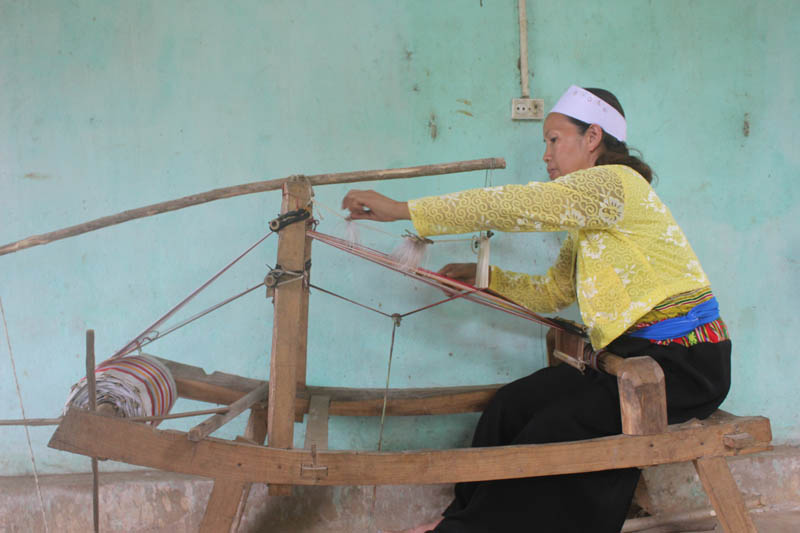
(HBO) – To Duong Thi Bin, brocade weaving is not only a job but also a passion. The woman, who comes from Luc hamlet, Yen Nghiep commune, Lac Son district of Hoa Binh province, always wants the brocade weaving will be preserved and developed in her hometown and her love for brocade has lit up faith of young generation in the future of the traditional craft.
The establishment of Luc Nghiep Thanh Limited Company,
a local brocade producer, has created jobs for more than 200 women in the
commune, showing the vitality of the brocade craft and those who are
enthusiastic about traditional cultures.
Since an early age, Bin has been very curious and
exciting when observing women in her village sitting in front of the looms and
weaving the brocades every day. That motivated her to learn how to weave in the
hope of making Muong colourful traditional dresses, pillows or blankets with
her own hands.
Over three decades have gone by since then, which is
also the time she has worked with brocade. She is now among the most skillful
at brocading and also the director of the company.

Duong Thi Bin works
ardently in front of the loom.
Bin used to be a member of the communal Women’s
Union. In 2008, she and other women at her hamlet
received 50 million VND from the employment support fund of the union to build
the looms. With a determination to preserve the brocade weaving which was
facing threat of oblivion, she decided to open her own brocade company two
years later, giving job opportunities for many local women.
At the beginning, her company has been given support
by the local industry promotion centre, which has provided 200 local workers with
three-month training courses on weaving. Now the company has many skillful weavers,
capable of passing their knowledge to others.
As the company’s leader, Bin joined hands with her workers to create numerous
brocade products like bags, scarves, skirts and shirts.
Bin said that her great passion for brocade beauty has required her to work to
preserve the country’s traditional craft by spreading it among the young
generation. Since the company was set up, communal women have stronger
attachment to brocade weaving.
In the first days, Bin herself found consumption markets for her brocade
products. After joining local fairs and those held in neighbouring provinces,
her products have been present in many localities across the country like Thanh
Hoa, Phu Tho, Son La and
Ho Chi Minh
City. Although there has been yet large order, her
company still maintains small ones. Old ethnic women sell brocades at rural
markets as a way to protect the culture.
Currently, the company has 168 members, however, the number of weaving looms
reaches 300 at peak.
Bin and six or seven skillful women opened brocade training courses for the
younger generation in the commune. They share weaving experience in their free
time to complete their weaving skills. Products made by the company are famous
for good quality, diversified designs and reasonable prices, thus gaining trust
from customers./.
Hoa Binh province has carried out multiple programmes and initiatives to revive its cultural heritage which has gradually fallen into oblivion through the ebbs and flows of history.
The most prominent and defining feature in the prehistoric era of Hoa Binh is the Hoa Binh Culture. The Culture was first discovered in Hoa Binh. The significant prehistoric culture represents not only Vietnam but also Southeast Asia and southern China. Through excavations of cave sites in the limestone regions of Hoa Binh, French archaeologist M. Colani introduced the world to a "Stone Age in Hoa Binh province – Northern Vietnam" in 1927. On January 30, 1932, the First Congress of Far Eastern Prehistorians, held in Hanoi, officially recognised the Hoa Binh Culture.
Known as the "Land of Epic History”, Hoa Binh province, the gateway to Vietnam’s northwest, boasts a strategic location and a unique cultural tapestry woven by its ethnic minority communities.
The People's Committee of Luong Son District recently held a ceremony to receive the certificate recognizing Sau Communal House in Thanh Cao Commune as a provincial-level historical and cultural site.
Recognising the importance of cultural heritage preservation in protecting and promoting the value system of Vietnamese culture, and serving socio-economic development in the new period, Party committees and local administrations in Hoa Binh province have identified it as a key task in the cultural development strategy. The province has been making efforts in mobilising resources, creating consensus among people and engaging ethnic communities in preserving and promoting cultural identity.
Hoa Binh province has captured growing attention both domestically and internationally for its distinctive cultural heritage and rich history. Most notably, it has been renowned for its famous Hoa Binh culture, considered the cradle of ancient Vietnamese civilisation. Looking ahead to significant milestones in 2025 and the 140th anniversary of province establishment in 2026, Hoa Binh Newspaper presents a comprehensive overview of the province's development across economic, social, cultural, tourism, and security domains.



